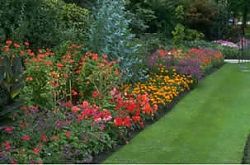Green Practices
PLMS recycles 100% of our green waste.
Turf
PLMS maintains a healthy stand of grass at its locations by practicing proper mowing, watering, and fertilization techniques. A healthy stand of grass can help prevent erosion, filter contaminants from rainwater, and is efficient at converting carbon dioxide to oxygen which helps to cleanse the air.
PLMS also ensures sharp blades are used for each mowing to prevent tearing and injuring the grass.
Integrated Plant and Pest Management (IPM)
One of the best ways to “green” a landscape is to place plants in the right location and utilize native species. Native plants typically are already adapted to the weather, soil and sun patterns for our region. Additionally, the native plants will attract native butterflies, birds and bees which will enhance the beauty of the landscape and help it grow.
PLMS trains it crews in IPM and how to prevent pest problems without resorting to routine spraying of herbicides, insecticides or fungicides. IPM results in fewer and less toxic chemicals contaminating surface and ground water. When lawns and plants are treated with pesticides, irrigation or rain may convey the pesticides from concrete or asphalt into storm drains. An IPM program for landscaping combines several steps to limit weed growth and prevent infestations of insects, rodents or other pests.
PLMS first stresses cultural control including the selection of disease-resistant plant varieties, proper irrigation, fertilization, pruning and planting at the right time of the year. PLMS also uses physical control to change conditions such as temperature, light and/or humidity to prevent pest problems. Landscape fabric, for example, shades out weeds and regular pruning of dense plants allows better air circulation and helps to prevent disease.
If chemical treatment is necessary, PLMS recommends “spot treating” the problem because widespread treatments may eliminate beneficial organisms as well. PLMS believes that applying unneeded pesticides over a large area is an unsafe practice and an avoidable waste or our client’s money.
Other “Green” Options
Rain Gardens
A rain garden is a man-made depression in the ground that is used as a landscape tool to improve water quality. The rain garden forms a ‘bioretention area’ by collecting water runoff and stored it. The water is filtered and slowly absorbed by the soil. Rain gardens are designed with a dip at the center to collect the rain and melting snow.
Rains gardens are suitable in both residential and commercial situations and should be placed so that the impervious surfaces will drain into the depression area. The overall purpose is to minimize the volume and improve the quality of water entering conventional storm drains and nearby streams.
Plant choices for rain gardens include hardy native species that thrive in our ecosystem without chemical fertilizers and pesticides. Many rain gardens feature shrubs as well as wild flowers and grasses.
Green Roofs
Green Roofs or vegetative roofs contain a layer of living plants on top of the structure and the waterproofing elements.
Why are green roofs such a great idea?
First they help to reduce roof storm water runoff. Green roofs can have positive environmental, social, and financial implications. The benefits include:
- aesthetic improvement
- waste diversion
- storm water management (quantity and quality)
- improve air quality
- new amenity spaces
